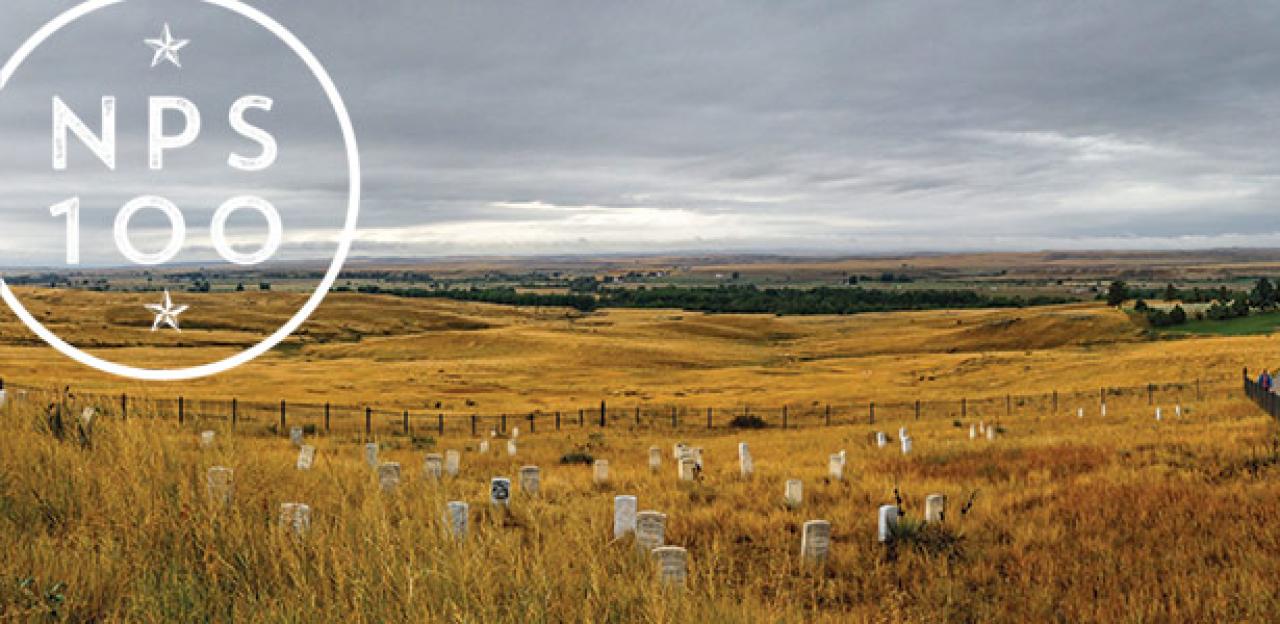Little Bighorn Battlefield National Monument

Denice Swanke, Little Bighorn Battlefield National Monument Superintendent, reflects on this Indian Wars battlefield in celebration of 100 years of the National Park Service.
Little Bighorn Battlefield National Monument
Crow Agency, Mont. | June 25-26, 1876 | Federal Battlefield Park Since 1946 | 765.44 Acres
At Montana’s Little Bighorn Battlefield National Monument, we honor all who participated in the 1876 battle at which Lakota and Cheyenne warriors defeated the 7th U.S. Cavalry in one of the most famous and decisive encounters in American history. This hallowed ground holds a unique place in the national consciousness as the high-water mark in the 400-year struggle of American Indians against the encroachment of European Americans. Yet the battlefield’s cultural legacy far transcends its military significance.
Little Bighorn Battlefield National Monument preserves and interprets a near-pristine field of engagement that includes critical combat sites, archaeological artifacts and numerous monuments commemorating the combatants. Completed in 2013, the congressionally authorized Indian Memorial honors the many American Indian perspectives and interpretations of the battle and its outcomes, their heroic sacrifice and their struggle to preserve and defend their homeland and traditional way of life. The memorial serves as a living tribute and, as Enos Poor Bear, Sr., an Oglala Lakota elder shared, “a message for the living … power through unity.”
“The dedication of the memorial to their fallen held great significance to the people of the tribes involved in the Battle of the Little Bighorn. At long last their achievement at arms was recognized. Their stories of the battle, once ignored or considered irreconcilable, had been increasingly validated — even confirmed — by scholars and battle students so that their testimony now comprised an important reservoir to enrich interpretation at the park. The people’s ownership was acknowledged and their dignity affirmed.”
— Jerome A. Greene on the 2003 dedication of the Indian Memorial at Little Bighorn Battlefield
For many, this is a place of reflection. Looking out over the prairie, visitors to this sacred place are deeply moved by the commemorative markers that indicate the casualty sites of both 7th U.S. Cavalry soldiers and Indian warriors alike. In addition to those who died in battle here, the Custer National Cemetery is a public memorial and the final resting place of more than 5,000 veterans of conflicts from the Indian Wars through the Korean War. It is a place of quiet reverence, where we honor the service and sacrifice of all veterans and their families.
Each year during the battle anniversary, visitors from all around the world come to learn about the tumultuous events of June 25–26, 1876. Multigenerational visits are common here. Perhaps a Lakota woman brings her children to see where their ancestors won the day in a fight to defend a way of life. A grandfather may bring his adult children, and their children, to share stories of the cavalry and horses and western expansion. School teachers reflect on how the more balanced stories we tell now vary from narrower versions they learned as youth.
Repeat and first-time visitors alike are inspired when they learn about acts of bravery and courage on the battlefield. People are deeply moved by this landscape and the events that transpired here. A common refrain we hear is: “You can almost see and hear what it must have been like here during the battle.” Battle tactics are still studied here during military “staff rides.”
We have so much to share with you — not just the resources to help you research and answer many questions about the late 19th-century, but also more than 800 acres of spectacular Montana prairie. Here, you can stretch your legs while traveling across the western plains; meditate on the government policies that have shaped our nation; and reflect on the meaning of honor and sacrifice, as exemplified by those on both sides of this conflict.
Park staff, as well as visitors, commonly experience profound personal reflection on this historic event and its role in our history. A visit to this battlefield will impact you in ways you may not expect. For some, it is a life-changing experience. This is a powerful place, and today, it is also a peaceful site.
Working here is an honor. Every day brings new and different activities and sights. Some days, park employees work with visitors to locate a loved one interred in Custer National Cemetery. During peak summer visitation, rangers engage visitors from sunrise to sunset, providing impassioned interpretive talks and answering countless questions. In winter months, visitation slows, allowing for reflection and observation in this unique landscape.
Whether you are able to make it here during the National Park Service centennial in 2016 or not, I challenge you to come, visit and “Find Your Park” while you experience all that Little Bighorn Battlefield National Monument has to offer. Share with us what this place means to you! And, if you visit on August 25, 2016, I invite you to share a slice of birthday cake with us as we celebrate 100 years of service.


